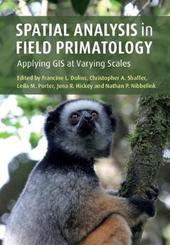
|
Spatial Analysis in Field Primatology: Applying GIS at Varying Scales
Paperback / softback
Main Details
Description
From foraging patterns in a single tree to social interactions across a home range, how primates use space is a key question in the field of primate behavioral ecology. Drawing on the latest advances in spatial analysis tools, this book offers practical guidance on applying geographic information systems (GIS) to central questions in primatology. An initial methodological section discusses niche modelling, home range analysis and agent-based modelling, with a focus on remote data collection. Research-based chapters demonstrate how ecologists apply this technology to a suite of topics including: calculating the intensity of use of both range and travel routes, assessing the impacts of logging, mining and hunting, and informing conservation strategies.
Author Biography
Francine L. Dolins is an Associate Professor of Comparative Psychology at the University of Michigan-Dearborn, USA. Her research investigates spatial cognition, navigation and foraging behavior with nonhuman primates in the lab using virtual reality, and also conducts field research, to integrate the understanding of species' cognitive capacities with socio-ecological factors. She has published two edited books with Cambridge University Press: Attitudes to Animals: Views in Animal Welfare (1999); and Spatial Cognition, Spatial Perception: Mapping the Self and Space (2010). Christopher A. Shaffer is Assistant Professor of Anthropology at Grand Valley State University, Michigan, and Principal Investigator of the Konashen Ecosystem Health Project. His primary research and teaching interests focus on community ecology and behavioral ecology, particularly in the context of human-nonhuman animal interactions and natural resource management. Leila M. Porter is Professor of Anthropology and Presidential Engagement Professor at Northern Illinois University. She studies the behavior and ecology of tamarins and Goeldi's monkeys in South America, specifically their diet, ranging, and patterns of infant care. Jena R. Hickey served as the Conservation Scientist for the International Gorilla Conservation Programme (IGCP) for 5 years. With over 20 years of professional experience, Jena has held positions with state and federal agencies, academic institutions, and not-for-profit organizations. She focuses on species occurrence, abundance, spatial distributions, movements, and habitat use, as well as how anthropogenic factors shape these response variables. Nathan P. Nibbelink is Professor of GIS and Spatial Ecology in the Warnell School of Forestry and Natural Resources, University of Georgia. He serves as Director of the Center for Integrative Conservation Research and the Integrative Conservation Ph.D. program. His research uses spatially explicit models to address landscape connectivity in a changing world, and to inform conservation and management of species and ecosystems.
Reviews'... the editors provide an excellent primer on GPS and GIS fundamentals that deftly expands to include research findings using more advanced methods. This resource covers applications of GPS and GIS directly relevant to readers from many areas of conservation biology who already use or want to use telemetry, GPS, or GIS analysis. This reviewer recommends the volume to any interested reader: it is not just for primatologists and will be an excellent reference for all researchers and students with biogeography, wildlife management, or technical GIS interests. Highly recommended.' C. A. Badurek, Choice '... the editors of this book have done an admirable job bringing together and synthesizing a wide range of analytic methods and topics involving spatial data. This volume will serve as an excellent reference for anyone interested in spatial analyses.' Sarie Van Belle, Quarterly Review of Biology 'Spatial Analysis in Field Primatology: Applying GIS at Varying Scales is the first integrated guide outlining the best practices in GPS or applying GIS to research questions specific to primatology, thus filling a gap in the methodological literature. It is an engaging and compelling read; in 20 chapters encompassing literature reviews and empirical studies, it comprehensively instructs the reader in how specific methods and technologies can be applied to broaden our understanding of the spatial aspects of primate behavioral and population ecology. A great addition to the burgeoning field of GPS and GIS within primatology, I highly recommend it for early- to mid-career primatologists and research groups who can apply the information to their own investigations about species' behavior, ecological knowledge, and conservation. It can also potentially be a valuable resource for a wider audience including postgraduate or advanced undergraduate classes geared toward methods in field primatology, in addition to senior groups looking to analyze existing data in new ways. The clear research priorities and future directions laid out in the text will stimulate such researchers to overcome the practical issues currently experienced, contribute to primate conservation, and advance the field more rapidly in a way that is appropriate, accurate, and ethical.' Lauren Wiseman-Jones, American Journal of Physical Anthropology 'Some chapters provide a good entry point to spatial analysis in field primatology, while other chapters are more advanced. All of them will leave you curious to dig deeper into the literature. The quality of the writing (and of the conceptual content) is very high throughout: the individual authors and editors are to be commended for putting together an authoritative volume that successfully captures the essential nature of GIS use by primatologists at the beginning of the 21st century.' Amanda Suzzi, Evolutionary Anthropology
|